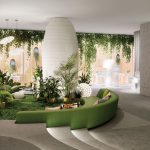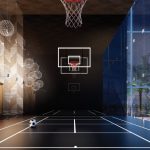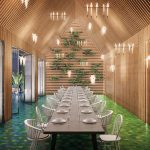Quito, la capital del Ecuador y primera ciudad Patrimonio Cultural de la Humanidad, se encuentra en pleno proceso de renovación de su imagen urbana y arquitectónica. Cuatro proyectos arquitectónicos diseñados por grandes estudios internacionales, que se están construyendo simultáneamente, coadyuvan decididamente en este proceso, mientras otros tantos están en proceso de diseño.
Los diseñadores Philippe Starck y Marcel Wanders y los arquitectos Bernardo Fort-Brescia y Laurinda Spear (Arquitectonica) junto al arquitecto ecuatoriano Tommy Schwarzkopf de Uribe & Schwarzkopf, son los responsables de este momento transformador de la arquitectura ecuatoriana.
La construcción de un nuevo sistema de transporte, Metro (tren subterráneo) y la salida del aeropuerto del corazón de la ciudad, han posibilitado la densificación y el crecimiento en altura de la urbe que antes restringía la altura de sus edificaciones por el paso de los aviones. Hoy liberada de esa atadura, permite construir edificios de hasta 24 pisos y más, en esta capital que roza las nubes a 2.800 metros de altura sobre el nivel del mar, que es cruzada por la línea ecuatorial (paralelo cero), y está rodeada por volcanes nevados.
Estos proyectos de vanguardia llamados a convertirse en hitos de la ciudad, son referentes tanto desde su volumetría exterior como desde su espacialidad interior. Este quizás sea uno de los elementos más importantes ya que el proyecto arquitectónico está concebido en una estrecha colaboración con los diseñadores industriales y de interiores. Así, el edificio YOO Quito, cuya arquitectura es producto de la colaboración entre la firma internacional Arquitectónica con Tommy Schwarzkopf, cuenta con el sello de Philippe Starck y John Hitchcox, en su línea YOO. Este trabajo interior plantea tres ejes fundamentales, natura, cultura y minimal. Natura, evocando el deseo y pasión que tienen los citadinos por traer la esencia de la naturaleza al ambiente urbano. Cultura, que recrea objetos historicistas en la decoración, combinándolos con un minimalista moderno que incorpora vidrio, metal, texturas de concretos y colores neutros.
Por otra parte, en el proyecto YOO Cumbayá, de los mismos autores, es la arquitectura la que va a la naturaleza, “Aquí estás en el cielo. Estás en el bosque. Estás en el centro de la vida” como lo describiera Starck. Este conjunto de oficinas y viviendas, está llamado a ser paradigmático por como se liga al entorno natural y cultural, generando su propio “centro urbano y paisajístico”. Proponiendo un particular estilo de vida que parte de un diseño interior personalizado, y en la creación de amplios espacios exteriores comunes, verdes, a nivel del suelo y en fachadas y cubiertas. Esto con una variado equipamiento para el descanso, la recreación y el deporte, vinculados a los espacios verdes exteriores. Las ideas de confort funcional y de creatividad lúdica incorporan el factor sorpresa en el diseño de los espacios compartidos. El aporte de diseño ecológico se centra en minimizar el impacto solar por aleros y superficies verdes, y el control energético con sensores de luz, aislamiento térmico, generación de fuentes propias de energía y utilización de materiales de bajo impacto ecológico.
En otra importante arteria de la ciudad (Av. 6 de Diciembre), ya en sus últimas etapas de construcción el edificio Atelier diseñado por Arquitectónica y U&S, se propone un importante cambio en la imagen urbana, con fachadas que juegan con líneas extraídas de un trazado básico modulado, logra establecer otra escala, otro ritmo, otras texturas en las superficies arquitectónicas. El edificio adquiere una doble piel modulada, una de base que ordena las aberturas y otra superpuesta que genera movimiento, sombras y privacidades.
Los edificios YOO de Quito y Cumbaya, así como Atelier proponen algo singular respecto al tradicional uso del suelo en esta capital, brindando generosos espacios públicos, alentando a una vida urbana contemporánea propia de las grandes capitales. Así, el peatón, olvidado por la supremacía del vehículo en los trazados urbanos, se vuelve un protagonista, un usuario cuyo sentido de pertenencia trasciende su departamento, un transeúnte invitado a recorrer visualmente espacios diseñados pensando en la posibilidad de disfrutar, de sentir, no solo de usar, percibe claramente que se ha aligerado la acostumbrada barrera de lo privado en la ciudad, que se han concebido nuevos espacios públicos que la enriquecen. Estos promueven no solo el tránsito placentero entre edificios, sino el descanso y el encuentro, en lugares creados para disfrutar del tiempo libre e incluso del trabajo. Los espacios compartidos no son solo abiertos o cerrados, son espacios de transición que poseen condiciones para funcionar en diversas condiciones climáticas.
Por otra parte en el proyecto Oh, ubicado en el mismo eje vial de YOO Quito y cuya visión le pertenece a U&S, plantea un concepto nuevo desde los estético e inmobiliario. La arquitectura de los renombrados arquitectos Bernardo Fort-Brescia y Laurinda Spear, de Arquitectonica, transforma a la torre de 18 pisos en un esbelta escultura urbana, que desplaza los planos de la fachada, haciéndolos girar en un movimiento extraordinario que parece enroscarse en el cielo quiteño, para el goce de todos lo que por allí transiten. Una volumetría que rompe todos los esquemas de lo edificado en esta importantes avenidas de la ciudad. Mientras, lo más emocionante sucede en su interior, donde el renombrado y multipremiado diseñador holandés Marcel Wanders, inspirado por la flora y fauna ecuatoriana, ha creado espacios asombrosos, transformándolos en experiencias para ser vividas. Wanders parte también de una trilogía conceptual que se resume en los elementos fundamentales, tierra, aire y fuego. Tierra en donde usa materiales auténticos en tonos tierras, aire en cuyos ambientes predomina la luz natural, logrando sensaciones de serenidad, suavidad y tranquilidad y fuego que es sorpresa, contrastes que combinan artesanías, patrones y colores formando una yuxtaposición de materiales que resplandecen. Goce estético y placer funcional, o como el lo describe Wanders, “crear un entorno de amor, vivir con pasión y hacer que nuestros sueños más emocionantes se hagan realidad”.
El futuro de la ciudad de Quito desde lo arquitectónico, se ve prometedor. La decidida participación de promotores privados, en especial de Uribe & Schwarzkopf que ha tomado la iniciativa con los proyectos de vanguardia descriptos, está haciendo de esta Capital una ciudad cosmopolita, con una mejora cualitativa en la vida urbana cotidiana. Por primera vez el Centro Histórico de Quito tendrá su contraparte contemporánea digna de ser visitada y de ser vivida.
Imágenes
© Uribe & Schwarzkopf
(YOO Quito, YOO Cumbaya, Atelier y Oh Residencias)
Texto
Rómulo Moya Peralta arq.
Trama
Más información
http://www.usconstructores.com
http://www.yoocumbaya.com
http://www.usconstructores.com/en/atelier/
http://www.yooquito.com
http://www.ohquito.com
English version
Bernardo Fort-Brescia, Laurinda Spear, Philippe Starck and Marcel Wanders transform the urban landscape of Quito
Quito, the capital of Ecuador and the first Cultural Heritage of Humanity, is in the process of renewing its urban and architectural image. Four architectural projects designed by important international studios, which are being built simultaneously, contribute decisively in this process, while others are in the design process.
Designers Philippe Starck and Marcel Wanders, and architects Bernardo Fort-Brescia and Laurinda Spear (Arquitectonica), along with the ecuadorian architect Tommy Schwarzkopf from Uribe & Schwarzkopf are responsible for this transforming moment in the ecuadorian architecture.
The construction of a new transportation system; the subway and the exit of the airport from the heart of the city, have made possible the densification and growth in height of the city, reasons that previously restricted the height of its buildings by the plane passing. Now freed from this bondage, it allows buildings of up to 24 floors and more, in this capital that slashes the clouds at 2,800 meters above sea level, crossing the equatorial line (parallel zero), and surrounded by snowy volcanoes.
These avant-garde projects destined to become landmarks of the city, are referring as much from its external volumetry as from its interior space. This is perhaps one of the most important elements since the architectural project is conceived, in close collaboration with industrial and interior designers. Thus, the YOO Quito building, whose architecture is the result of the collaboration between the international firm Arquitectónica with Tommy Schwarzkopf, has the seal of Philippe Starck and John Hitchcox, in its YOO line. This inner work raises three fundamental axes; nature, culture and minimal. Nature, evoking the desire and passion that the citizens have to bring the essence of nature to the urban environment. Culture, which recreates historicist objects in the decoration, combining them with a modern minimalist touch incorporating glass, metal, concrete textures and neutral colors.
On the other hand, in the YOO Cumbayá project, by the same authors, it is the architecture that goes to the nature. “Here you are in heaven. You are in the woods. You are at the center of life “as Starck would described it. This set of offices and homes are called to be paradigmatic, because it is linked to the natural and cultural environment, generating its own “urban and landscape center.” Proposing a particular lifestyle that starts from a custom interior design, and creating wide common outdoor spaces, green at ground level, on facades and decks. This with a varied of rest, recreation and sport equipment, linked to outdoor green spaces. The ideas of functional comfort and playful creativity incorporates the surprising factor in the design of shared spaces. The contribution of ecological design focuses on minimizing solar impact by eaves and green surfaces, energy control with light sensors, thermal insulation, generation of own energy sources and use of materials with low ecological impact.
In another important artery of the city (Av. 6 de diciembre), and in its final stages of construction, the Atelier building designed by Arquitectónica and Uribe & Schwarzkopf, a major change is proposed in the urban view, with facades playing with lines from a modulated basic tracing, manages to establish another scale, another rhythm and other textures in the architectural surfaces. The building acquires a double modulated skin, a basic ordering and other superimposed openings that generate movement, shadows and privacies.
The YOO Quito and YOO Cumbayá buildings, as well as Atelier, offer something unique regarding the traditional use of the land in this capital, providing generous public spaces, encouraging a contemporary urban life typical of the big capitals. Thus, the pedestrian, forgotten by the supremacy of the vehicle in the urban paths, becomes a protagonist, a user whose sense of belonging transcends his department, a passer-by inviting to go through visually designed spaces thinking about the possibility of enjoying and not only wanting to use; clearly perceiving that the private accustomed barrier in the city has been lightened and that new public spaces have been enriched. These promotes not only the pleasant transit between buildings, but also the resting and meetings in places created to enjoy free time and even work. The shared spaces are not only open or closed, they are spaces of transition that have the conditions to operate in diverse climatic conditions.
On the other hand, the Oh Project is located on the same axis as YOO Quito and whose vision belongs to Uribe & Schwarzkopf, presenting a new esthetic and real estate concept. The architecture of the renowned architects Bernardo Fort-Brescia and Laurinda Spear, of Arquitectónica, transforms the 18-storey tower into a slender urban sculpture, displacing the facade and turning them into an extraordinary movement that seems to be curled up in the Quito sky, for the enjoyment of all the people that go through there. This volumetry, breaks all the schemes built up in this important avenues of the city. Meanwhile, the most exciting thing is in the inside, where the renowned and multi-awarded Dutch designer Marcel Wanders, inspired by Ecuadorian flora and fauna, has created amazing spaces, transforming them into experiences to be lived. Wanders, also starts from a conceptual trilogy that is summed up in the fundamental elements; earth, air and fire. Earth, where it uses authentic materials in earth tones, air in whose atmospheres natural light prevails, achieving sensations of serenity, softness and tranquility and fire that surprises with contrasts that combine crafts, patterns and colors forming a juxtaposition of glowing materials. Enjoying aesthetic and functional pleasures, or as Wanders describes it, “create an environment of love, live with passion and make our most exciting dreams come true.”
From the architectural perspective, the future of the city of Quito looks promising.The decisive participation of private promoters, especially from Uribe & Schwarzkopf, who has taken the initiative with the avant-garde projects described, is making this capital a cosmopolitan city with a qualitative improvement in the daily urban life. For the first time, the Historic Center of Quito will have its contemporary counterpart worthy of being visited and lived.































